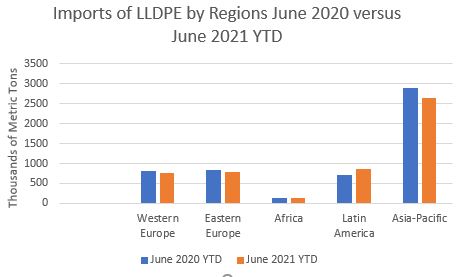These regional trends were the same for both polymers: lower imports into Western and Eastern Europe and, with the biggest impact on global trade volumes, Asia-Pacific; increased imports into the smaller markets of Africa and Latin America; reduced exports from North America; mixed trends for Middle East exports; higher exports from Asia-Pacific.
HDPE global trade volume through June was 11.8 million tons, down 8% from the first half of 2020 (based on latest available reporting countries; estimated 92% complete.)
Regions importing lower volumes of HDPE YTD were: Asia-Pacific 3.7 million tons, down 16%; Western Europe, 0.89 million tons, down 3%; Eastern Europe, 0.78 million tons, down 2%.
Latin America was a growth market for HDPE, importing 0.85 million tons, up 14%, as was Africa with 0.54 million tons, up 11%. Both regions reported substantially higher volumes from the Middle East and Asia-Pacific.

HDPE exports from North America fell 26%, totaling 1.3 million tons. Middle East exported 3.9 million tons, down 2%.
LLDPE global trade volume, including ethylene-alpha-olefin copolymers, was 9.9 million tons through June, down 3%. Regions reporting lower imports of Linear were similar to HDPE: Asia-Pacific, 2.6 million tons, down 9%; Western Europe, 0.75 million tons, down 9%; Eastern Europe, 0.78 million tons, down 7%.

Latin America and Africa were also growth markets for LLDPE, 0.87 million tons, up 24% and 0.14 million tons, up 10%, respectively.
Total exports from North America dropped 6%, to 2.3 million tons; Middle East exports showed a 2% increase, to 2.1 million tons.
From International Trader Publications’ World Trade Analyses for HDPE and LLDPE/EAOC, continuously updated analyses of trade between countries and region based on ITP’s database of 100 countries.
